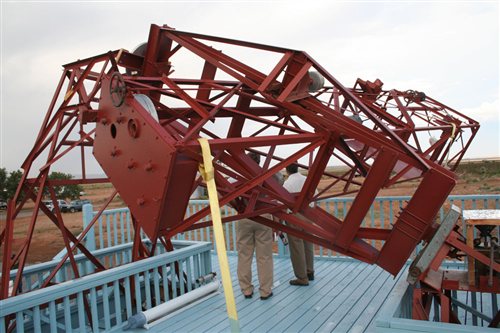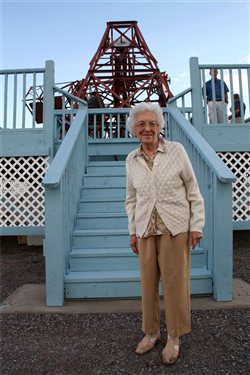 On Thursday night, September 17, at Rancho Hidalgo near Animas, New Mexico, Astronomy magazine editors joined a group of some 50 people to dedicate the magazine’s new observatory facility and to dedicate Pluto discoverer Clyde Tombaugh’s personal telescope in its new location. Now called Pluto Park, the area of the ranch has been set aside for astronomy education goals by Rancho Hidalgo developer Gene Turner, in conjunction with his large and enthusiastic team of partners, notably builder Tim McShane.
On Thursday night, September 17, at Rancho Hidalgo near Animas, New Mexico, Astronomy magazine editors joined a group of some 50 people to dedicate the magazine’s new observatory facility and to dedicate Pluto discoverer Clyde Tombaugh’s personal telescope in its new location. Now called Pluto Park, the area of the ranch has been set aside for astronomy education goals by Rancho Hidalgo developer Gene Turner, in conjunction with his large and enthusiastic team of partners, notably builder Tim McShane.
Editors note: You can see the full image gallery of the dedication ceremony in our Online Reader Gallery.
The magazine’s observatory has been a long time coming. When I first arrived at Astronomy as a young, enthusiastic kid from Ohio, there was talk about someday having a dark-sky facility for the magazine for observing, story writing, equipment testing, and remote-control imaging. I recall Richard Berry and Robert Burnham, driving forces at the magazine, talking about such possibilities, but the pressure of producing the world’s most popular magazine on its subject relegated these talks to occasional fits and starts. The day I arrived at the magazine was 27 years ago last Wednesday! Thus, a lesson in persistence! Thanks for making this powerful capability finally happen are due to Gene Turner, Tim McShane, Publisher Kevin Keefe, and Kalmbach executives Butch Boettcher and Chuck Croft.
The observatory will be used for imaging of deep-sky objects and planets, and also Hydrogen-alpha imagery of the Sun. Imaging will be controlled remotely from our offices in Waukesha, Wisconsin. The observatory now contains a 14-inch SCT and a refractor for solar imaging, both fitted with CCD cameras and of course a solar filter on the refractor. You will soon begin to see images made with both telescopes filter into the magazine and onto our web site. Editors will also occasionally travel to the ranch for hands-on, dark-sky viewing with other telescopes such as Gene’s 30-inch reflector.
 The moment was a proud one last night, having the dedication coupled with the first-light event for Pluto discoverer Clyde Tombaugh’s reassembled 16-inch telescope (pictured at right), which stands adjacent to the magazine’s observatory. The last time I had used the Tombaugh telescope was more than 20 years ago, accompanied by David Levy, when it was in Clyde’s backyard in Las Cruces. I vividly recall how stunned I was through the whole night observing things with the man who discovered Pluto and seeing him manhandle the big metallic tube so effectively.
The moment was a proud one last night, having the dedication coupled with the first-light event for Pluto discoverer Clyde Tombaugh’s reassembled 16-inch telescope (pictured at right), which stands adjacent to the magazine’s observatory. The last time I had used the Tombaugh telescope was more than 20 years ago, accompanied by David Levy, when it was in Clyde’s backyard in Las Cruces. I vividly recall how stunned I was through the whole night observing things with the man who discovered Pluto and seeing him manhandle the big metallic tube so effectively.
 We lost Clyde 12 years ago, but his widow, Patsy Tombaugh (pictured at right), arrived on the scene last night and made a terrific impression on the whole assembled group. At age 97, she is still going strong, and she recounted many stories of Clyde, his life, their school days, and their marriage, as well as aspects of Clyde’s research. I stood and listened in amazement. What a wonderful woman she is. Additionally, Clyde’s daughter, Annette Sitze, and her husband, Wilbur, were in attendance. So was a close friend of Clyde’s: ALPO founder and longtime director Walter H. Haas. (ALPO stands for the Association of Lunar and Planetary Observers.)
We lost Clyde 12 years ago, but his widow, Patsy Tombaugh (pictured at right), arrived on the scene last night and made a terrific impression on the whole assembled group. At age 97, she is still going strong, and she recounted many stories of Clyde, his life, their school days, and their marriage, as well as aspects of Clyde’s research. I stood and listened in amazement. What a wonderful woman she is. Additionally, Clyde’s daughter, Annette Sitze, and her husband, Wilbur, were in attendance. So was a close friend of Clyde’s: ALPO founder and longtime director Walter H. Haas. (ALPO stands for the Association of Lunar and Planetary Observers.)
Several friends and notables gave short talks, beginning with Gene Turner, the head man. Then came a very entertaining remembrance of Clyde by David Levy, Astronomy’s contributing editor and the man who wrote the definitive biography of Tombaugh, Clyde Tombaugh: Discoverer of the Planet Pluto. I then spoke briefly about the Astronomy Observatory and my fondness for Clyde, and Patsy Tombaugh said a few words the crowd very much enjoyed. We then repaired to the sky, which was not cooperating. Indeed, the monsoon season has extended this year far longer than normal, and we had occasional rain as well as scattered clouds and “sucker holes” tempting us with brilliant constellations.
However, Gene Turner, Publisher Kevin Keefe, and I set alarms for 3 a.m. and wandered out to see a clear and amazingly beautiful sky. We observed for a while and have a good prognosis, it would seem, for a long evening of deep-sky observing tonight. Stay tuned for more.
Photos credit: David J. Eicher, editor